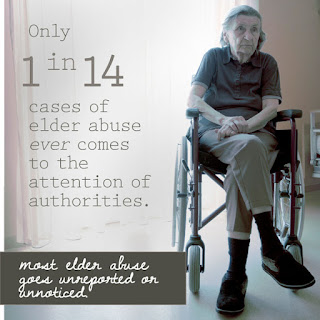After the death of her husband, eighty-six-year-old Mrs. Jones was befriended by Nancy, a local nurse. Since Mrs. Jones’s only family was out of state, Nancy began helping Mrs. Jones run small errands, such as grocery shopping and trips to the bank. Before long, Nancy had convinced Mrs. Jones to let her move in to help take care of her. Nancy began recommending expensive home improvements, ensuring Mrs. Jones that they were best for her. She even suggested that Mrs. Jones buy an expensive new sports car, an item Mrs. Jones had no interest in. Sometimes Nancy would lose her temper with Mrs. Jones and hit her or tell her she was useless.
 |
A study by the National Research Council estimates that only 1 in 14 cases of elder abuse ever comes to the attention of authorities - The National Center on Elder Abuse
|
In an effort to bring attention to this growing problem, World
Elder Abuse Awareness Day was established on June 15, 2006. It encourages
communities to promote awareness about elder abuse, neglect and exploitation. The National Center on Elder Abuse (NCEA) lists several ways to get involved in the
prevention of elder abuse and instructions on how to report it. Learn more
about how you can help at http://www.ncea.aoa.gov/.
Signs of elder abuse may be missed by professionals working with older Americans because of lack of training on detecting abuse. The elderly may be reluctant to report abuse themselves because of fear of retaliation, lack of physical and/or cognitive ability to report, or because they don’t want to get the abuser (90% of whom are family members) in trouble.
- The National Center on Elder Abuse
- The National Center on Elder Abuse
Elderly victims who are physically or emotionally abused can also seek financial assistance from the California Victim Compensation Program (CalVCP), which provides compensation to victims of violent crime. CalVCP provides assistance with medical and dental treatment, mental health services, income loss, funeral and burial expenses, home security, crime-scene cleanup and other crime-related expenses. If you are victim of elder abuse or would like more information about CalVCP, you can visit calvcp.ca.gov.
In 2050, it is estimated that 20% of the United States’ population will be over 65 years old, a 17% increase from 2010. This means 17% more people will be vulnerable to elder abuse. Please help to keep our elderly community safe by spreading the word and reporting abuse.
Julie Nauman is the Executive Officer for the Victim Compensation and Government Claims Board (VCGCB). VCGCB provides compensation for victims of violent crime and helps to resolve claims against the State.

